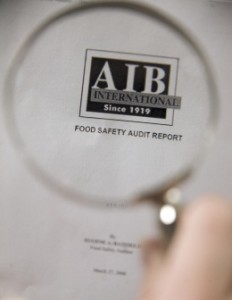Timothy D. Lytton and Lesley K. McAllister write in the 2014 Wisconsin Law Review 289, that private auditing is a significant component of food safety regulation. Typically, manufacturers, retail sellers, and food-service operators require their suppliers to obtain food safety certification from a private third-party auditor paid by the supplier. Auditors’ financial interest in acquiring accounts from suppliers who want the cheapest certification that they can obtain gives auditors incentive to reduce the rigor of audits. This constitutes a conflict of interest between the auditor’s private financial interest and its professional obligation to protect the public from food safety risks. Audit industry insiders and outside observers are well aware of this problem, and various institutional actors — both public and private — have developed oversight mechanisms to address it.
 We analyze the nature and sources of this conflict of interest in food safety auditing, efforts to prevent it, and responses when it occurs. Our focus is on institutional design — organizational structures, administrative routines, and professional norms. Part I of the Article describes how conflicts of interest lead some auditors to be less probing in their inspection of suppliers’ operations and to skew their risk evaluations in favor of suppliers’ desire for cheap certification. Part II of the Article surveys the different oversight mechanisms currently in place or under development that aim to counteract auditors’ incentive to reduce the rigor of audits.
We analyze the nature and sources of this conflict of interest in food safety auditing, efforts to prevent it, and responses when it occurs. Our focus is on institutional design — organizational structures, administrative routines, and professional norms. Part I of the Article describes how conflicts of interest lead some auditors to be less probing in their inspection of suppliers’ operations and to skew their risk evaluations in favor of suppliers’ desire for cheap certification. Part II of the Article surveys the different oversight mechanisms currently in place or under development that aim to counteract auditors’ incentive to reduce the rigor of audits.
Conflict of interest is a structural feature of any system of private standards compliance in which the auditor is paid by the entity being audited. Other prominent examples include securities rating and environmental audits. Our analysis of food safety auditing aims to offer general insights into the comparative strengths and weaknesses of different responses to this problem.
We wrote, and repeated here, it’s time to change the discussion and the approach to safe food. Time to lose the religion: audits and inspections are never enough.
• Food safety audits and inspections are a key component of the nation’s food safety system and their use will expand in the future, for both domestic and imported foodstuffs, but recent failures can be emotionally, physically and financially devastating to the victims and the businesses involved;
• many outbreaks involve firms that have had their food production systems verified and received acceptable ratings from food safety auditors or government inspectors;
• while inspectors and auditors play an active role in overseeing compliance, the burden for food safety lies primarily with food producers;
• there are lots of limitations with audits and inspections, just like with restaurants inspections, but with an estimated 48 million sick each year in the U.S., the question should be, how best to improve food safety?
 • audit reports are only useful if the purchaser or food producer reviews the results, understands the risks addressed by the standards and makes risk-reduction decisions based on the results;
• audit reports are only useful if the purchaser or food producer reviews the results, understands the risks addressed by the standards and makes risk-reduction decisions based on the results;
• there appears to be a disconnect between what auditors provide (a snapshot) and what buyers believe they are doing (a full verification or certification of product and process);
• third-party audits are only one performance indicator and need to be supplemented with microbial testing, second-party audits of suppliers and the in-house capacity to meaningfully assess the results of audits and inspections;
• companies who blame the auditor or inspector for outbreaks of foodborne illness should also blame themselves;
• assessing food-handling practices of staff through internal observations, externally-led evaluations, and audit and inspection results can provide indicators of a food safety culture; and,
• the use of audits to help create, improve, and maintain a genuine food safety culture holds the most promise in preventing foodborne illness and safeguarding public health.
Audits and inspections are never enough: A critique to enhance food safety
30.aug.12
Food Control
D.A. Powell, S. Erdozain, C. Dodd, R. Costa, K. Morley, B.J. Chapman
Internal and external food safety audits are conducted to assess the safety and quality of food including on-farm production, manufacturing practices, sanitation, and hygiene. Some auditors are direct stakeholders that are employed by food establishments to conduct internal audits, while other auditors may represent the interests of a second-party purchaser or a third-party auditing agency. Some buyers conduct their own audits or additional testing, while some buyers trust the results of third-party audits or inspections. Third-party auditors, however, use various food safety audit standards and most do not have a vested interest in the products being sold. Audits are conducted under a proprietary standard, while food safety inspections are generally conducted within a legal framework. There have been many foodborne illness outbreaks linked to food processors that have passed third-party audits and inspections, raising questions about the utility of both. Supporters argue third-party audits are a way to ensure food safety in an era of dwindling economic resources. Critics contend that while external audits and inspections can be a valuable tool to help ensure safe food, such activities represent only a snapshot in time. This paper identifies limitations of food safety inspections and audits and provides recommendations for strengthening the system, based on developing a strong food safety culture, including risk-based verification steps, throughout the food safety system.
